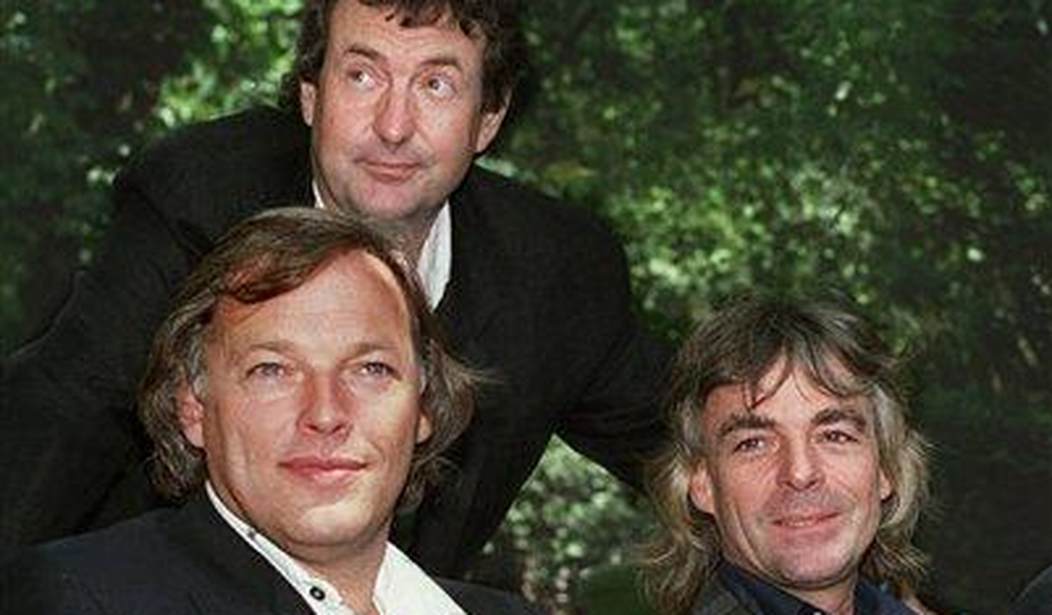Whom the gods destroy it seems, they first place in charge of Pink Floyd. By early 1968, after founding the group and writing its classic early songs, Syd Barrett (1946-2006) became, alongside Brian Wilson of The Beach Boys and Brian Jones of The Rolling Stones, one of rock’s most celebrated acid casualties. His role as bandleader and primary songwriter was eventually usurped by Roger Waters, who wrote the lyrics for Floyd’s massive selling 1970s output: Dark Side of the Moon, Wish You Were Here, Animals, and The Wall. During the making of the latter album, Waters would push keyboardist Rick Wright out of the group, and by 1985, decided that he wished the rest of the band were no longer here, either.
By 2006, Waters’ full-on embrace of reactionary leftwing politics led him down the rabbit hole of the anti-Israeli Boycott, Divestment, and Sanctions (BDS) movement, and a series of ugly anti-Semitic incidents, including Waters’ trademark pig, “flown” over his concert audiences with guidewires, sporting a Star of David. Waters would go on to compare Israel to Nazi Germany and attempted to defend his actions with a lame “I have many very close Jewish friends” statement in 2013.
Waters’ solo career began in the mid-‘80s when he decided that the rest of the band were “a spent force creatively.” As a result, guitarist David Gilmour, coming off the disappointing sales of his second solo album, About Face, and half-empty live dates to promote it, decided to revive the band name. He recruited Floyd drummer Nick Mason as his business partner, and the two brought back Rick Wright to the fold, initially in a somewhat limited capacity. They hired Bob Ezrin, who co-produced 1980’s The Wall, to ensure their next studio album would sound appropriately modern and high-tech in the era of MTV, and have continuity with their classic previous albums. As Mark Blake wrote in Pigs Might Fly, his 2007 history of the Floyd:
In truth, Gilmour had been fired up by the dispute with Waters, and was determined to make another Pink Floyd album. ‘Dave absolutely saw red, and finally got it together to go back to work,’ said Nick Mason. ‘One of the great spurs was the fact that Roger, hearing about the plans for a new album, had told him, “You’ll never do it.”’
The Floyd-as-trio’s first release, appropriately titled A Momentary Lapse of Reason in 1987, was designed as a springboard for a lengthy concert tour visiting some of the largest sports stadiums in America, England, Canada, Australia, and Japan. (Waters had developed a phobia about playing outdoor stadiums, which led directly to his writing The Wall album.) The tour to promote A Momentary Lapse of Reason lasted from September of 1987 until the final show in July of 1989. (Plus a one-off appearance in June of 1990 at Knebworth, England.)
The Delicate Sound of Sidemen
During the 1970s, as their album productions became increasingly complex, Floyd toured with an ever-growing number of stage musicians, until the tour to promote The Wall, when Waters conceived of an entire duplicate band wearing life masks of the actual Floyd members, which he dubbed “The Surrogate Band,” in order to give the audience the shock of discovering that who they thought were Pink Floyd actually were not. When Gilmour began planning the tour to promote A Momentary Lapse of Reason, he needed, essentially, his own surrogate band, but for very different reasons. First, he needed a bassist to replace Roger Waters. On the Momentary Lapse album, that role was filled by veteran studio bassist Tony Levin, who’s played with everyone from John Lennon and Paul Simon to Peter Gabriel, and was a member of the classic 1980s incarnation of King Crimson. During Floyd’s live tour however, Guy Pratt played bass. Pratt had previously toured with Icehouse when they opened for David Bowie in 1983, and David Gilmour’s tour the following year. Pratt was in for a shock when he first joined this iteration of Floyd, as Blake wrote in Pigs Might Fly:
However, arriving in Toronto for rehearsals, the band encountered some problems. Guy Pratt quickly discovered that he hadn’t actually been Pink Floyd’s first choice of bassist. ‘When we turned up to rehearse there were a few newspapers running articles about how Pink Floyd were in town to start their new tour and a lot of them said, “featuring Tony Levin on bass”. So I was there only because Tony hadn’t been available at the last minute. I was like, “Oh, great!”’
Because Mason and Wright had a fair amount of rust and nerves to shake off, they had duplicates as well, with Jon Carin doubling on keyboards and Gary Wallis on percussion. Gilmour had another reason for hiring younger, MTV-friendly faces to supplant his fellow Floyd members, as Blake wrote:
Aside from the dazzling special effects, the presence of younger and more flamboyant band members made a huge difference. The athletic leaps and bounds made by percussionist Gary Wallis to strike the highest cymbals in his drum cage diverted attention from the staid-looking, middle-aged gentleman playing the drum kit beside him. The elaborately coiffured saxophonist Scott Page was also given to strapping on a guitar and appearing on stage when he wasn’t actually needed. ‘Scott and Gary came with the territory,’ says Bob Ezrin. ‘This was meant to be a more visual show. There’s a lot of “Ooh-aah factor” to a Pink Floyd concert. People want to say, “Wow, look at that!” So they gave it to them.’
And they certainly “gave it to them.” While there were obviously rock acts in the 1970s and ‘80s with much more kinetic performers such the Rolling Stones, The Who, Bruce Springsteen, and Led Zeppelin, the Gilmour-era Floyd threw in the kitchen sink to work a football stadium: Lasers, rear-projected films, pigs and Spitfires roaring over the crowds on guidewires, explosions, and surround sound.
The Final Cut
The August 19-23, 1988 shows at Long Island, New York’s Nassau Coliseum were filmed by director Wayne Isham, who according to Rolling Stone, “used more than 100 cans of 35mm negatives to capture the concert.” (Others estimate over twice as many film cans consumed.) These were originally assembled into a concert video released on videotape and laserdisc in 1989 titled The Delicate Sound of Thunder. Curiously, that concert film was never released on either DVD or Blu-Ray until last year, as part of their mammoth retrospective Later Years package of CDs, DVDs, and Blu-Rays. For many, The Delicate Sound of Thunder was that box set’s true party piece, and it’s no surprise that a year later, Gilmour et al decided to release it as a standalone Blu-Ray disc at the much cheaper price of $35.48 (with the DVD version selling at $19.99), compared with the box set’s off-putting $300+ price tag last year.
As longtime Floyd creative associate Aubrey Powell has noted, The Delicate Sound of Thunder is “the only Pink Floyd concert film, ever, apart from Live at Pompeii. Apart from that, there is no other live film of the whole Pink Floyd band.” The original 1989 version in 4X3 format was released with hazy video in a slightly slow-motion style, very popular with MTV at the time. Which explains why it sat on the shelf for so long: Like the sonics of the Momentary Lapse of Reason album, that version of The Delicate Sound of Thunder was of its time, arguably much more so than Pink Floyd’s classic ‘70s output. Also, the band apparently was not happy with the original edit of the footage.
As Powell told another interviewer, all that slo-mo helped to hide some serious flaws with the original edit: “[I]n 1987 shooting a 35mm live concert was really working in the dark — no pun intended — and not like filming today. That’s why the film appeared so super-imposed and with dream-like dissolves when released on VHS and Laserdisc. The quality, in retrospect, was terrible. Having re-edited over a 14-month period a new and clean digitized version, I then cranked the film up to 4K. David Gilmour re-mixed the sound with Andy Jackson, as he was never really happy with the original in 5.1, which now in the cinema looks and sounds amazing.”
I’ll vouch for that. Played through a decent 5.1 system, the bass thunders, there’s plenty of surround sound, such as the cash register effects at the beginning of “Money,” and the mix is excellent. The 4K picture really captures the extended stage band in full flight, and is a time capsule of 1980s fashions and coiffures, as Rolling Stone noted last year in their review of the Later Years box set. “Gilmour’s solos soar, and you can see how gracefully he and everyone could move between the lasers in the baggy clothing of the era, and saxophonist Scott Page’s uber-mullet looks positively unreal as he juggles saxes.”
In their review of the stand-alone Blu-Ray disc this year, Rolling Stone adds that Isham’s original material was completely reworked, initially for its inclusion in the Later Years box set:
Film editor Benny Trickett took the film, since remastered in 4K, and worked with Aubrey Powell — a cofounder of the graphic arts group Hipgnosis, which created many iconic Pink Floyd covers, including Delicate Sound of Thunder — and assembled the new cut. Gilmour worked on the new release’s sound with engineer Andy Jackson and assistant David Iddins.
If I have one complaint with the new incarnation of The Delicate Sound of Thunder, it’s that the original 1989 cut wasn’t also included, as I had enjoyed that version both as a concert memento and a time capsule of the late MTV era. Even George Lucas has released DVD versions of the original cut of Star Wars, and it would have been easy to run off a copy of Delicate Thunder’s original cut and format, and throw it in, warts and all.
Incidentally, on its way to its DVD/Blu-ray release this fall, it was announced in late August that, as is often the case for concert videos, there would be a one-night-only screening in movie theaters in October. After months of lockdown, I was strongly looking forward to seeing Floyd on the big screen. This was quickly scrapped, for reasons that needn’t be explained for anyone reading this in December of 2020.
So, has Gilmour succumbed to the same dark forces that impacted Barrett and Waters during their tenures at the heart of the Floyd? In one sense, no. He made a massive amount of money from the two tours and albums his iteration of Pink Floyd recorded. But no one in 1994, when Pink Floyd released The Division Bell and promoted it with yet another huge world tour would have suspected that album would effectively be the end of the band’s career releasing new material. But the pressure to follow the works of Barrett and Waters must have been enormous, coupled with his inability to write lyrics as powerful as his two predecessors were capable of (and at their height, seemingly on command). I wish that Pink Floyd released new output throughout the ‘90s, just as the earlier Waters-led incarnation did during the 1970s. But for salvaging a group that Waters dismissed as “a spent force,” Gilmour did quite well for himself on his own terms, as highlighted spectacularly in the new Delicate Sound of Thunder discs.










Join the conversation as a VIP Member